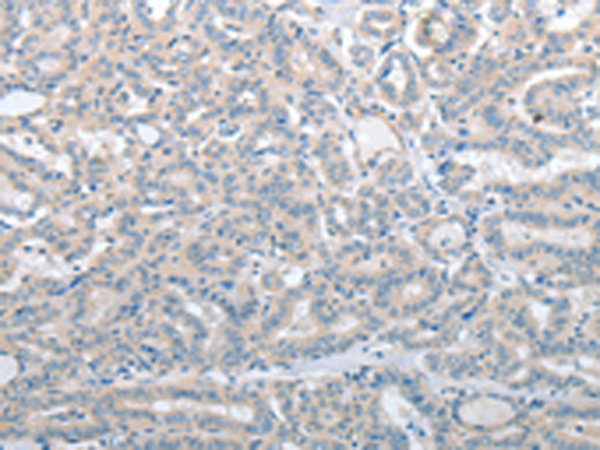

| WB | 咨询技术 | Human,Mouse,Rat |
| IF | 咨询技术 | Human,Mouse,Rat |
| IHC | 1/50-1/200 | Human,Mouse,Rat |
| ICC | 技术咨询 | Human,Mouse,Rat |
| FCM | 咨询技术 | Human,Mouse,Rat |
| Elisa | 1/2000-1/20000 | Human,Mouse,Rat |
| Aliases | DNPI; VGLUT2 |
| Host/Isotype | Rabbit IgG |
| Antibody Type | Primary antibody |
| Storage | Store at 4°C short term. Aliquot and store at -20°C long term. Avoid freeze/thaw cycles. |
| Species Reactivity | Human, Mouse, Rat |
| Immunogen | Synthetic peptide of human SLC17A6 |
| Formulation | Purified antibody in PBS with 0.05% sodium azide and 50% glycerol. |
+ +
以下是关于SLC17A6(VGluT2)抗体的3篇代表性文献及其摘要内容:
---
1. **文献名称**:*"VGLUT2 Antibodies: Validation of Specificity and Utility in Studying Glutamatergic Synapses"*
**作者**:Miyazaki et al.
**摘要**:该研究通过Western blot和免疫组化验证了SLC17A6(VGluT2)抗体的特异性,发现其能特异性标记中枢神经系统中谷氨酸能神经元的突触前终末,且在小鼠模型中与基因敲除样本对比显示无交叉反应性,支持其在突触功能研究中的应用。
---
2. **文献名称**:*"The Identification of Vesicular Glutamate Transporter 2 Suggests a Widespread Role in Excitatory Neurotransmission"*
**作者**:Fremeau et al.
**摘要**:本文首次克隆并鉴定了VGluT2(SLC17A6)蛋白,开发了特异性抗体。研究发现VGluT2广泛分布于脑干、丘脑等区域的谷氨酸能神经元中,与VGluT1形成互补分布,提示其在神经传递中的关键作用。
---
3. **文献名称**:*"Genetic Ablation of VGLUT2 in Neurons Disrupts Glutamatergic Signaling and Food Intake Regulation"*
**作者**:Hnasko et al.
**摘要**:利用SLC17A6抗体结合条件性基因敲除技术,研究显示VGluT2缺失导致小鼠谷氨酸释放显著减少,并引发摄食行为异常,证实VGluT2在调节能量代谢相关神经环路中的必要性。
---
4. **文献名称**:*"Altered Expression of SLC17A6 in Parkinson’s Disease Models"*
**作者**:Ziegler et al.
**摘要**:通过SLC17A6抗体检测帕金森病动物模型的脑组织,发现黑质和纹状体中VGluT2表达下调,提示谷氨酸能传递异常可能与疾病运动症状相关。
---
这些文献涵盖了抗体验证、分布研究、功能探索及疾病关联分析,为SLC17A6抗体的应用提供了多角度参考。
The SLC17A6 antibody targets the solute carrier family 17 member 6 (SLC17A6) protein, also known as vesicular glutamate transporter 2 (VGluT2). This transporter is primarily responsible for packaging the excitatory neurotransmitter glutamate into synaptic vesicles, a critical step in glutamatergic neurotransmission. VGluT2 is one of three vesicular glutamate transporters (VGluT1-3) and is predominantly expressed in subcortical regions of the central nervous system, including the thalamus, brainstem, and cerebellum, distinguishing it from VGluT1 (cortical/hippocampal) and VGluT3 (serotonergic/other neurons).
Antibodies against SLC17A6/VGluT2 are widely used in neuroscience research to identify and map glutamatergic neurons, study synaptic plasticity, and investigate neural circuits involved in sensory processing, motor control, and behavior. They are essential tools for immunohistochemistry (IHC), immunofluorescence (IF), and Western blotting (WB) applications. The specificity of SLC17A6 antibodies is often validated using knockout models or comparative analyses with other VGluT isoforms to ensure minimal cross-reactivity.
Research applications extend to neurodegenerative diseases (e.g., Alzheimer's, Parkinson's), psychiatric disorders (e.g., schizophrenia), and pain pathways, where glutamatergic dysregulation is implicated. Commercial SLC17A6 antibodies are typically raised in hosts like rabbit or mouse, with validation emphasizing tissue-specific staining patterns consistent with known VGluT2 expression. Proper controls, such as knockout validation or peptide blocking, are recommended to confirm antibody reliability in experimental setups.
×